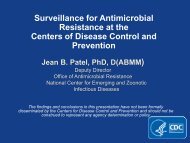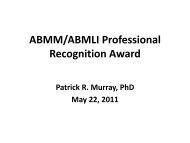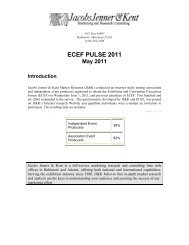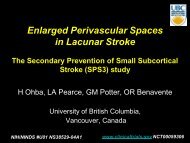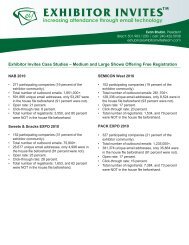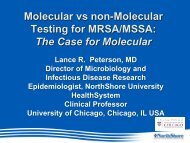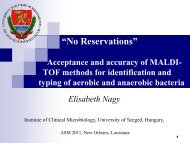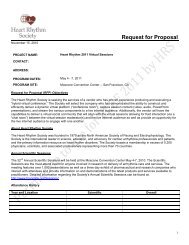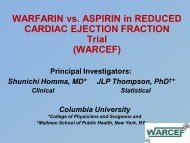Clinically Relevant, Cost-Effective Microbiology
Clinically Relevant, Cost-Effective Microbiology
Clinically Relevant, Cost-Effective Microbiology
You also want an ePaper? Increase the reach of your titles
YUMPU automatically turns print PDFs into web optimized ePapers that Google loves.
ASM 2011 Clinical Core Curriculum III<br />
Best Practices in the Work Up<br />
of Respiratory Cultures<br />
Yvette S. McCarter, PhD, D(ABMM)<br />
Director, Clinical <strong>Microbiology</strong> Laboratory<br />
Shands Jacksonville<br />
Professor of Pathology<br />
University of Florida College of Medicine-Jacksonville
Objectives<br />
Discuss the value of the gram stained smear as a<br />
reliable rapid diagnostic tool.<br />
Discuss criteria for assessing specimen quality by<br />
microscopic screening.<br />
Describe recognition and reporting of organisms by<br />
genera rather than organism morphology.<br />
Discuss the criteria for and use of “mixed flora” in<br />
respiratory gram stains.<br />
Describe cost-effective, clinically-relevant strategies<br />
for laboratory work up of lower respiratory tract<br />
specimens.<br />
2
The major goal of the clinical microbiology<br />
laboratory is to provide information of maximal<br />
clinical or epidemiological usefulness as rapidly<br />
as is consistent with acceptable accuracy and<br />
minimal cost.<br />
Jay P. Sanford, MD (1974)<br />
The culture of lower respiratory specimens may<br />
result in more unnecessary microbiologic effort<br />
than any other type of specimen.<br />
Raymond C. Bartlett, MD (1974)<br />
3
Pathogenesis of Pneumonia<br />
Aspiration of colonizing flora<br />
Inhalation of aerosols<br />
Hematologic seeding<br />
4
Oral Flora or Potential Pathogen?<br />
Oral Flora<br />
Corynebacterium spp.<br />
Coagulase negative<br />
staphylococci<br />
Staphylococcus aureus<br />
Neisseria spp.<br />
Haemophilus influenzae<br />
Streptococcus<br />
pneumoniae<br />
Moraxella catarrhalis<br />
Potential Pathogens<br />
Staphylococcus aureus<br />
Haemophilus influenzae<br />
Streptococcus<br />
pneumoniae<br />
Moraxella catarrhalis<br />
Gram negative bacilli<br />
Gram negative bacilli<br />
Oral flora – 10 10-1012 CFU/mL<br />
5
Utility of the Gram Stain<br />
Rapid, inexpensive, informational<br />
Evaluation of specimen quality<br />
Identify superficially contaminated specimens<br />
Enhance discrimination between samples with<br />
potential pathogens vs. colonizing flora<br />
Presumptive organism ID<br />
Guide rational selection of preliminary<br />
antibiotic therapy<br />
Guides interpretation of culture results<br />
6
Utility of the Gram Stain<br />
Majority of the literature supports the clinical<br />
usefulness of gram stained sputum smears<br />
Wide range in reported sensitivity (35-96%<br />
and specificity (12-85%)<br />
Reference standard – sputum culture<br />
Variable care in specimen collection – “Good<br />
quality” specimen<br />
Multiple criteria for assessing Gram stain smears<br />
7
Cao et al.<br />
J Infect<br />
Chemother<br />
2004<br />
Musher et al.<br />
CID 2004<br />
Rosón et al.<br />
CID 2000<br />
Anelavis et al.<br />
J Infect 2009<br />
Blot et al.<br />
Am J Respir Crit<br />
Care Med 2000<br />
Utility of the Gram Stain<br />
Sensitivity Specificity Population Comments<br />
Spn: 81%<br />
Hflu: 86%<br />
Mcat: 91%<br />
Spn: 98%<br />
Hflu: 95%<br />
Mcat: 98%<br />
Pediatric<br />
Spn: 57% NA Adult Included pts<br />
on antibiotics<br />
Spn: 57%<br />
Hflu: 82%<br />
Spn: 82%<br />
Hflu: 79%<br />
Saur: 76%<br />
GNR: 78%<br />
EA: 91%<br />
PTC: 70%<br />
Spn: 97%<br />
Hflu: 99%<br />
Spn: 93%<br />
Hflu: 96%<br />
Saur: 96%<br />
GNR: 95%<br />
EA: 64%<br />
PTC: 96%<br />
Adult (CAP) Presumptive<br />
Dx in 80%<br />
Adult (CAP) Specific<br />
criteria for<br />
Gram stain<br />
Adult (HAP)
Utility of the Gram Stain<br />
Gram stain DOES NOT diagnose the presence<br />
of pneumonia<br />
Once pneumonia diagnosed Gram stain is<br />
useful in determining probable etiologic agent<br />
9
Utility of the Gram Stain<br />
Heineman et al. 1977. J Clin Microbiol 6:518-27<br />
50% of the information gleaned from sputum cultures<br />
is clinically misleading in the absence of correlation<br />
with direct gram stain results<br />
Gleckman et al. 1988. J Clin Microbiol 26:846-49<br />
Selection of appropriate monotherapy 94% of the time<br />
when guided by bacterial morphotypes from the gram<br />
stain<br />
10
IDSA/ATS<br />
Consensus Guidelines on the<br />
Management of CAP<br />
Sputum cultures may have a major impact on the<br />
care of an individual patient<br />
Antibiotic susceptibility patterns<br />
Pretreatment Gram stain and culture of expectorated<br />
sputum should be performed only if a good-quality<br />
specimen can be obtained<br />
The benefit of a sputum Gram stain is 2-fold:<br />
Broadens initial empirical coverage for less common<br />
etiologies (S. aureus or gram-negative bacilli)<br />
Validates subsequent sputum culture results<br />
Mandell et al. 2007 CID 44 (Suppl 2):S27-S72<br />
11
IDSA/ATS<br />
Consensus Guidelines on the<br />
Management of HAP, VAP and HCAP<br />
Reliable tracheal aspirate Gram stain<br />
Direct initial empiric antimicrobial therapy<br />
May increase the diagnostic value of the clinical<br />
pulmonary infection score<br />
Culture results are not available immediately<br />
Gram stain can be used to increase the likelihood of<br />
a subsequent positive culture and guide antibiotic<br />
therapy before culture results<br />
Less use of antibiotics with no adverse outcomes<br />
Improved mortality<br />
Neiderman, Craven et al. 2005. Am J Respir Crit Care Med 171:388-416<br />
12
Gram Stain Screening Criteria<br />
Standardization<br />
Consistent smear interpretation<br />
Establish quality of specimen<br />
Optimal smear preparation and staining<br />
When not to apply the criteria<br />
Legionella culture<br />
Use interpretive comments<br />
13
Gram Stain Screening Criteria<br />
COLLECT DATE/TIME 2/10/11 1655 RESP CULTURE SPECIMEN: Sputum<br />
RECEIVE DATE/TIME 2/10/11 1800<br />
DIRECT SMEAR SUGGESTS:<br />
No neutrophils<br />
Many squamous epithelial cells<br />
REPORT STATUS: FINAL 2/10/11<br />
Not representative of lower respiratory tract secretions. Culture not<br />
performed. Please consult <strong>Microbiology</strong> if clinical considerations<br />
warrant complete processing of this specimen. (Specimen will be<br />
held 5 days).<br />
12
Gram Stain Screening Criteria<br />
Author (year) Method Minimum criteria<br />
Bartlett (1974) Sum of PMN/LPF (10-25,<br />
1+; >25, 2+), mucus (1+);<br />
SEC (10-25, -1; >25, -2)<br />
Murray and Washington<br />
(1975)<br />
Geckler et al. (1977)<br />
Score of >0<br />
Enumerate SEC/LPF 10 PMN/SEC<br />
Morris et al. (1993) Enumerate SEC/LPF and<br />
presence/absence of<br />
organisms/OIF<br />
Zaidi and Reller (1996) Presence/absence of<br />
organisms/OIF<br />
>5 PMN/SEC<br />
Poor Quality<br />
14 14
Good Quality<br />
15
“Mixed Flora”<br />
Used only with respiratory specimens<br />
Use of objective criteria (# of organisms present per<br />
OIF) to distinguish resident flora or colonizers from<br />
potential pathogens:<br />
Morphology Call if:<br />
Gram negative bacilli ≥ 10 organisms/OIF<br />
Moraxella ≥ 25 organisms/OIF<br />
Staph ≥ 50 organisms/OIF<br />
S. pneumoniae ≥25 pairs/OIF<br />
Bartlett 1982 JAMA Wright et al. 1990 Am J Med<br />
Normandin et al. 1997 ASM C-91<br />
18
DIRECT SMEAR SUGGESTS:<br />
Cells:<br />
Moderate neutrophils<br />
No squamous cells<br />
Bacteria:<br />
Few Gram negative rods<br />
Many Gram positive diplococci<br />
Moderate Gram negative diplococci<br />
Few Gram positive rods<br />
Few Gram negative coccobacilli<br />
Rare Gram positive cocci in clusters<br />
Few yeast<br />
“Mixed Flora”<br />
DIRECT SMEAR SUGGESTS:<br />
Cells:<br />
Moderate neutrophils<br />
No squamous cells<br />
Bacteria:<br />
Gram positive diplococci suggestive<br />
of Pneumococcus<br />
Mixed flora<br />
19
Interpretation and Reporting of<br />
Organisms in Direct Smears<br />
Bartlett. 1982. JAMA 247:857-59<br />
Designation of organism genera more useful than<br />
description of organism morphology<br />
Bartlett et al. 1991. Diagn Microbiol Infect Dis<br />
14: 195-201<br />
Reliable differentiation of Gram negative bacilli<br />
Bacteroides or Haemophilus – 95%<br />
Enteric Gram negative bacilli – 82%<br />
Pseudomonas – 56%<br />
20
Enteric-like Gram negative bacilli<br />
Report only if > 10 seen per oil immersion field<br />
21
Gram negative coccobacilli suggestive of Haemophilus<br />
Report only if > 10 seen per oil immersion field<br />
YM<br />
22
Non-enteric Gram negative bacilli<br />
Report only if > 10 seen per oil immersion field<br />
YM<br />
23
Gram negative diplococci suggestive of Moraxella<br />
Report only if > 25 seen per oil immersion field<br />
25
Gram positive cocci suggestive of Pneumococcus<br />
Report only if > 25 pairs seen per oil immersion field<br />
YM<br />
26
Gram positive cocci suggestive of Staphylococcus<br />
Report only if > 50 seen per oil immersion field
Not Routinely Reported in Respiratory Gram Stains<br />
Gram positive cocci suggestive of Streptococcus
Not Routinely Reported in Respiratory Gram Stains<br />
Gram positive bacilli<br />
suggestive of<br />
Bacillus/Clostridium<br />
29<br />
Gram positive bacilli<br />
suggestive of Diphtheroids
Not Routinely Reported in Respiratory Gram Stains<br />
Yeast<br />
30
Mixed Flora Criteria<br />
Morphology Call if:<br />
Gram negative bacilli ≥ 10 organisms/OIF<br />
Moraxella ≥ 25 organisms/OIF<br />
Staph ≥ 50 organisms/OIF<br />
S. pneumoniae ≥25 pairs/OIF<br />
Streptococcus<br />
Gram positive bacilli<br />
Yeast<br />
31
Work up of Respiratory Cultures<br />
There are no clear guidelines for working up<br />
bacterial cultures<br />
Literature<br />
Colleagues<br />
There seems to be a need for some<br />
consistency when performing culture work up<br />
Uniformity in work up and reporting of<br />
bacterial isolates<br />
When to perform AST<br />
32
Work up of Respiratory Cultures<br />
Premise:<br />
Specimen Quality<br />
PMN are an indication of infection or inflammation<br />
SEC indicate superficial contamination<br />
If a specimen contains a large amount of SEC,<br />
superficial contamination is likely<br />
The specimen should be recollected<br />
Extensive testing on heavily mixed cultures should<br />
not routinely be performed<br />
33
Work up of Respiratory Cultures<br />
Q-Score System<br />
Q234 System<br />
PMN-association System<br />
Sharp, SE, et al. 2004. Cumitech 7B, Lower Respiratory Tract<br />
Infections. ASM Press, Washington, DC<br />
34
Work up of Respiratory Cultures<br />
Key:<br />
0 = no cells<br />
1 = 1-9/lpf<br />
2 = 10-24/lpf<br />
3 = >25/lpf<br />
Q-Score System (RC Bartlett, 1974)<br />
Q-SCORE = # of potential pathogens (PP) to work up<br />
Report value<br />
Neutrophils (+)<br />
Squamous cells (-)<br />
0 -1 -2 -3<br />
0 3 0 0 0<br />
+1 3 0 0 0<br />
+2 3 1 0 0<br />
+3 3 2 1 0<br />
Q0 = no cult<br />
Q1 = 1PP<br />
Q2 = 2PP<br />
Q3 = 3PP<br />
35
Work up of Respiratory Cultures<br />
“Q-Score” System<br />
Up to 3 organisms can be considered<br />
potential pathogens (PP) and be worked up<br />
(ID/AST) if from a good quality specimen<br />
(Q3)<br />
The lower quality of the specimen (e.g., the<br />
more SEC present) the fewer the organisms<br />
worked up (Q2, Q1)<br />
36
Work up of Respiratory Cultures<br />
“Q-Score” System<br />
# PP in culture < Q-score: work up PP with ID/AST<br />
(2PP) (Q3)<br />
# PP in culture > Q-score: Look to Gram stain<br />
(3PP) (Q2)<br />
Work up PP that were seen in Gram stain with ID/AST<br />
If all PP in the culture are seen in Gram stain = do not<br />
work up; perform morphological identification (MID)<br />
37
Work up of Respiratory Cultures<br />
Q234 System (SE Sharp, 2002)<br />
Gram stain Quality Check: PMN & SEC<br />
Reject any sputum for culture according to normal<br />
protocol<br />
Culture work up is based on number of PP present:<br />
2 PP = Work up (< 2 PP)<br />
4 PP = MID<br />
3 PP = Look to Gram stain<br />
NOTE: If mixed flora > PPs = MID PP<br />
Work up to 2 PP if they<br />
are seen in the GS<br />
If all 3 PP are seen in the<br />
GS, MID all 3<br />
38
Work up of Respiratory Cultures<br />
PMN-Association System<br />
Success in microscopic evaluation relies on strict<br />
cytological criteria<br />
>25 PMN, < 10 SEC<br />
>25 PMN, 10 PMN per SEC (10:1 ratio)<br />
Evaluate the presence of predominant<br />
morphotypes associated with WBC<br />
1 morphotype 10 organisms/OIF 39
Work up of Respiratory Cultures<br />
PMN-Association System<br />
Quantitation of organisms in smears<br />
inconsistent and inaccurate<br />
Technologist variability<br />
Do not rely on quantitation to determine<br />
relatedness to infection PMN more<br />
predictive<br />
Work up organisms seen in association with<br />
PMN<br />
40
Example 1: Sputum<br />
GS: many PMN (+3), few SEC (-1), many enteric-like gram<br />
negative bacilli, moderate gram positive cocci<br />
suggestive of Staph, few Mixed flora (yeast)<br />
CULT: moderate P. aeruginosa, moderate E.coli, moderate<br />
Staph aureus, few yeast<br />
WORK UP:<br />
Q Score (Q2=2PP):<br />
Q234 (3PP):<br />
41
Example 1: Sputum<br />
GS: many PMN (+3), few SEC (-1), many enteric-like gram<br />
negative bacilli, moderate gram positive cocci<br />
suggestive of Staph, few Mixed flora (yeast)<br />
CULT: moderate P. aeruginosa, moderate E.coli, moderate<br />
Staph aureus, few yeast<br />
WORK UP:<br />
Q Score (Q2=2PP): Work up E. coli and S. aureus<br />
MID P. aeruginosa; Report Mixed flora<br />
Q234 (3PP):<br />
42
Example 1: Sputum<br />
GS: many PMN (+3), few SEC (-1), many enteric-like gram<br />
negative bacilli, moderate gram positive cocci<br />
suggestive of Staph, few Mixed flora (yeast)<br />
CULT: moderate P. aeruginosa, moderate E.coli, moderate<br />
Staph aureus, few yeast<br />
WORK UP:<br />
Q Score (Q2=2PP): Work up E. coli and S. aureus<br />
MID P. aeruginosa; Report Mixed flora<br />
Q234 (3PP): Work up E. coli and S. aureus<br />
MID P. aeruginosa; Report Mixed flora<br />
43
Example 2: Sputum<br />
GS: many PMN (+3), moderate SEC (-2), many nonentericlike<br />
gram negative bacilli, moderate Mixed flora<br />
CULT: many P. aeruginosa, moderate Staph aureus, few<br />
viridans Strep<br />
WORK UP:<br />
Q Score (Q1=1PP):<br />
Q234 (2PP):<br />
44
Example 2: Sputum<br />
GS: many PMN (+3), moderate SEC (-2), many nonentericlike<br />
gram negative bacilli, moderate Mixed flora<br />
CULT: many P. aeruginosa, moderate Staph aureus, few<br />
viridans Strep<br />
WORK UP:<br />
Q Score (Q1=1PP): Work up P. aeruginosa<br />
MID S. aureus; Report Mixed flora<br />
Q234 (2PP):<br />
45
Example 2: Sputum<br />
GS: many PMN (+3), moderate SEC (-2), many nonentericlike<br />
gram negative bacilli, moderate Mixed flora<br />
CULT: many P. aeruginosa, moderate Staph aureus, few<br />
viridans Strep<br />
WORK UP:<br />
Q Score (Q1=1PP): Work up P. aeruginosa<br />
MID S. aureus; Report Mixed flora<br />
Q234 (2PP): Work up P. aeruginosa and S. aureus<br />
Report Mixed flora<br />
46
Example 3: Tracheal Aspirate<br />
GS: many PMN (+3), few SEC (-1), many Mixed flora (few<br />
enteric-like GNB; moderate gram positive cocci<br />
suggestive of Staph)<br />
CULT: moderate diphtheroids, moderate coag negative<br />
Staph, few E.coli, rare Staph aureus<br />
WORK UP:<br />
Q Score (Q2=2PP):<br />
Q234 (2PP):<br />
47
Example 3: Tracheal Aspirate<br />
GS: many PMN (+3), few SEC (-1), many Mixed flora (few<br />
enteric-like GNB; moderate gram positive cocci<br />
suggestive of Staph)<br />
CULT: moderate diphtheroids, moderate coag negative<br />
Staph, few E.coli, rare Staph aureus<br />
WORK UP:<br />
Q score (Q2=2PP): Work up E. coli and S. aureus<br />
Report Mixed flora<br />
Q234 (2PP):<br />
48
Example 3: Tracheal Aspirate<br />
GS: many PMN (+3), few SEC (-1), many Mixed flora (few<br />
enteric-like GNB; moderate gram positive cocci<br />
suggestive of Staph)<br />
CULT: moderate diphtheroids, moderate coag negative<br />
Staph, few E.coli, rare Staph aureus<br />
WORK UP:<br />
Q-Score (Q2=2PP): Work up E. coli and S. aureus<br />
Report Mixed flora<br />
Q234 (2PP): Report Mixed flora<br />
MID E. coli and S. aureus **<br />
** If mixed flora > PPs = MID PP<br />
49
Premise for “Q” Systems<br />
Based on published prevalence of potential<br />
pathogen colonization of the oropharynx<br />
The more superficially contaminated the<br />
specimen, the higher the # of colonizing<br />
organisms present<br />
Quality of specimen is important in determining<br />
acceptability of specimen and extent of culture<br />
work up<br />
If organisms seen in smear, greater chance they<br />
are associated with an infective process<br />
50
“Q” Systems Advantages<br />
Offers a consistent approach for interpreting<br />
cultures<br />
Based on specimen quality (primarily SEC)<br />
Based on organisms seen in Gram stain<br />
(organism seen on smear should be in a<br />
significant number in the specimen, >10 5 /mL)<br />
Limits number of organisms worked up from<br />
mixed cultures reporting of misleading<br />
information minimized<br />
51
“Q” Systems Advantages<br />
No Potential Pathogen is ever ignored<br />
All potential pathogens reported (may not<br />
perform full ID/AST)<br />
Pathogens that some believe should “ALWAYS<br />
BE WORKED UP” (S. aureus, -strep, P.<br />
aeruginosa ) are identified and always<br />
indicated on the report<br />
Can be modified to include screening for<br />
MRSA, VRE, etc.<br />
52
“Q” Systems Advantages<br />
Guidelines<br />
The Q Systems offer guidelines for a<br />
systematic approach to culture interpretation<br />
These Guidelines are just that = Guidelines!<br />
Exceptions can be made<br />
Any concerned physician can consult with<br />
microbiology to have further work performed<br />
on any culture if clinically indicated<br />
53
References<br />
Sharp, SE, et al. 2004. Cumitech 7B, Lower<br />
Respiratory Tract Infections. ASM Press,<br />
Washington, DC<br />
C Matkoski, SE Sharp, and DL Kiska. 2006.<br />
Evaluation of the Q Score and Q234 Systems<br />
for <strong>Cost</strong>-<strong>Effective</strong> and <strong>Clinically</strong> <strong>Relevant</strong><br />
Interpretation of Wound Cultures. J Clin<br />
Microbiol 44:1869-1872.<br />
54
Conclusions<br />
Gram stain of direct respiratory specimens is useful<br />
DO IT WELL and USE IT<br />
Specimen quality assessment<br />
Rapid presumptive identification<br />
Guide culture work up<br />
Watch your P’s and Q’s<br />
Determine your “P’s” (potential pathogens)<br />
Pick one of the “Q’s” (Q systems)<br />
Report consistent and clinically-relevant respiratory<br />
culture results<br />
55
Questions<br />
yvette.mccarter@jax.ufl.edu<br />
56




